Evan Ifekoya
~Resonant Frequencies
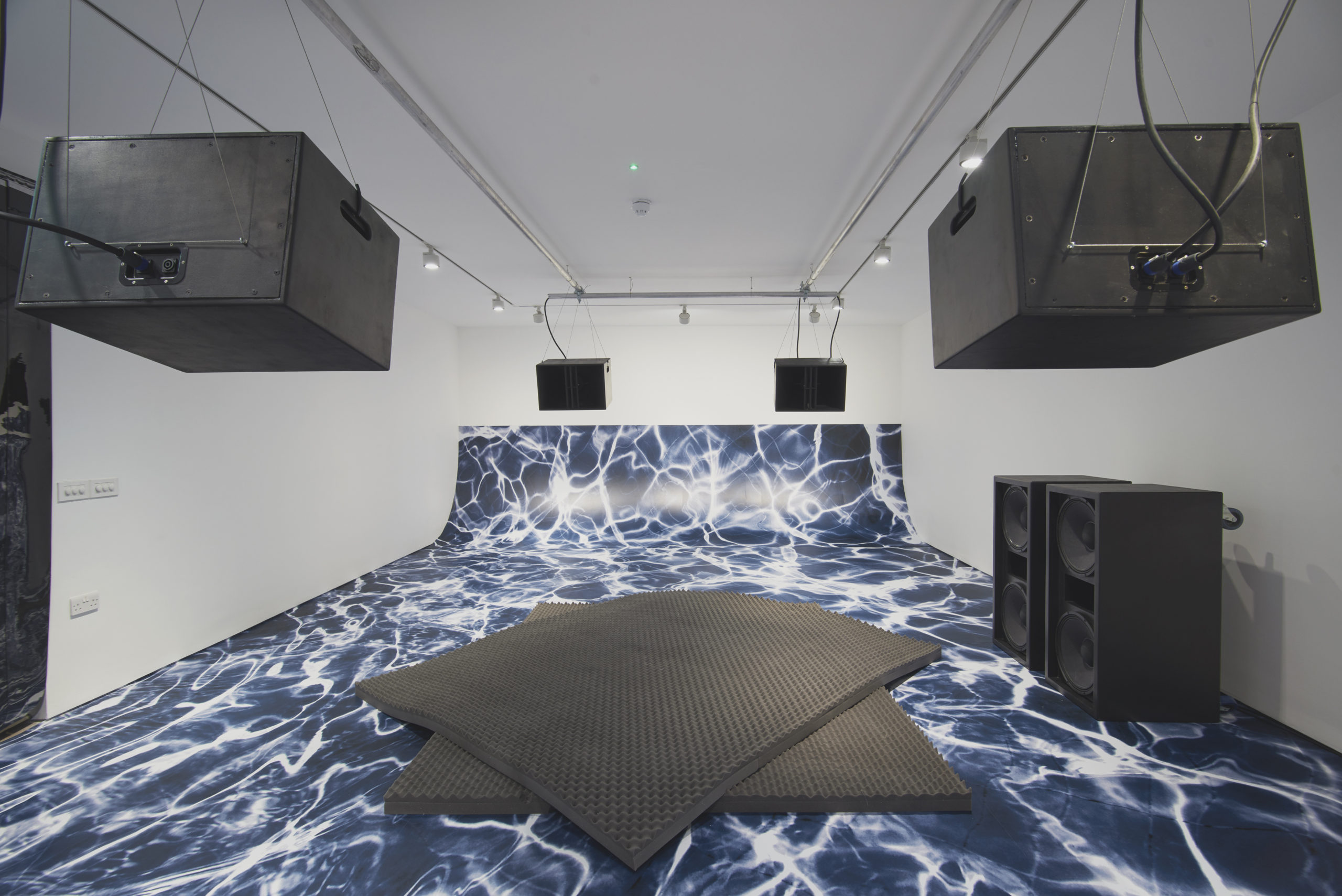
Evan Ifekoya, Ritual Without Belief, installation view at Gasworks, London, 2018. Photo by Andy Keate.
I think that first and foremost sound is an aural experience, it’s something we hear. But after that, you’re actually engaging with many different stages of your nervous system. When you hear sound move through the body, you are experiencing a kind of physiological, sonic trance. It stretches you out and connects you to your extremities. I really like that, that idea that the body can be stretched out.
Walk down to the edge of a riverbank on a warm spring day. The glassy top of the stream has melted from new sunlight, maybe the first of the year, but the air is still cool and heavy and sharp, sounds cutting through it like icepicks. Concentrate on the liquid gurgles, find a keynote. Build out the rest of your scale. (It may help to close your eyes.) Allow your voice to blend with the sounds that you hear. There should be no distinction between the sounds you make and the sounds you receive. You are the sound of the river; the sound of the river is the sound of the world.
This meditation is one of many text scores composed by Pauline Oliveros, an American composer best known for her Deep Listening exercises, which channel the conscious act of listening through the architecture of the body. “Listening to space changes space. Changing space changes listening,” suggests Oliveros. This mantra overlaps with the chief tenant of Earthseed, a religion conceived by sci-fi author Octavia E. Butler in her Parables series: “All that you touch, you change. All that you change, changes you. The only lasting truth is change.” Between these belief systems and between sound and the body, the practice of artist and energy worker Evan Ifekoya also takes root, stretching between the cellular and celestial to channel a kind of collective healing.
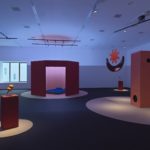
Evan Ifekoya, ~Resonant Frequencies, installation view at Migros Museum, Zurich, 2022. Photo by Stefan Altenburger.
“The last few years I’ve become really interested in what sound can do to transform the body: physically, mentally, and spiritually,” Ifekoya says. “I’m always wondering what I can do to support a particular kind of listening.” Working across sculpture, sound, scent, and film, they create multisensory installations that operate as listening environments, with no hierarchy or chronology imposed on listeners’ navigation of the space. Time distorts and wrinkles around their architectural interventions, becoming fluid and malleable like a sheet of film left out in the sun. Centering around durational sound pieces that are distributed throughout each installation, Ifekoya’s works become worlds with their own cosmologies that invite the viewer in through a number of listening stations, or portals.
I think the sound pieces that I make are an attempt to give a particular experience of presence. How the presence of sound can transform a moment, the body, the environment. They are also an attempt to give an experience of space and time as not being fixed, to create spaces as a field that can transform and shift. There’s a part of me that is trying to create a moment of safety and radical acceptance. To be held by the space.
In Deep Listening there is a type of synesthesia that seeps out through the pores of the body; sensations we assign to certain parts start to circulate elsewhere. (“Walk so quietly that the bottoms of your feet become your ears,” Oliveros suggests.) The sensation of melting into one’s environment, an act of becoming-with the world, is a feeling that Deep Listening tends to induce. But for Ifekoya, the act of listening is not about erasing the body, but finding multiples through it. While gravitating towards sound, they do not snub out the other senses: light, smell, texture, and the feeling of time shifting – less as an arrow, more like a circle – all play crucial roles in their listening environments, where the body becomes a vessel or carrier bag for immaterial forms of knowledge.
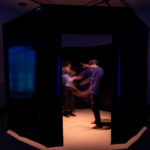
Evan Ifekoya, ~Resonant Frequencies, installation view at Migros Museum, Zurich, 2022. Photo by Stefan Altenburger.
Sound is a great tool to make people consider the multiplicity of their identities. We exist in multiple different capacities simultaneously, and through sound, you can engage those different selves really quickly. There’s also something about sound in particular that’s really intimate – the way that we hear sound in the ear and it affects the inner ear, and is also transmitted to the brain through the bones. It feels really intimate in that way.
“How can we be intentional about exploring time as something that’s nonlinear, or more malleable than we think?” Ifekoya asks. In the artist’s latest solo presentation, ~Resonant Frequencies at Zurich’s Migros Museum, they constructed a series of five portal units made from different materials including glass, wood, water, and iridescent foil. A seven-hour-long sound piece stretches across these units, uniting them as a singular environment – but not without its own inner friction. Take, for instance, The Vibration (Sun Light), and The Undulation (Sun Dark).
Within the former, listeners recline on a vibrating mattress, bathing in the LED light of an overhead sun as it shifts from orange to blue with the daily passing of time, the layered rumbling of sound finding harmony within the resonant frequencies of their bodies. Inside The Undulation, listeners stand face-to-face with a human-height speaker which occasionally evokes the sound of a club-like environment. Sending and receiving, lightness and darkness. The exhibition constantly fluctuates around its own frequency, seeking out an equilibrium while guiding visitors to find theirs. In The Welcome, this frequency appears within a shallow, vibrating water pool; suitably, it can only be perceived through a constant state of motion.
I think about sound as fluid, and how it’s always moving through something else; water is an especially important medium for me in this context. Sound waves are similar to water waves in that they occupy a particular place in time and space, except they’re not as long-lasting. The only time they’re occupying a particular space is when they’re there. But they carry information.
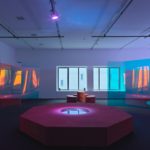
Evan Ifekoya, ~Resonant Frequencies, installation view at Migros Museum, Zurich, 2022. Photo by Stefan Altenburger.
The whole idea of resonance as a particular moment or frequency makes me think about when sound hits an object or an environment – the sound that is not absorbed by the object or the environment is reflected back out again, so objects reverberate with previous sounds. Above all I think about how objects and living beings have a relationship to each other that exists before human language.
Inside Ifekoya’s environments, I think a lot about layers. The steady accumulation of ordinary affects, as Lauren Berlant and Kathleen Stewart build up in The Hundreds, and the ways that collectivity congeals around this practice of attention. The ways that affect might hit individual registers across the bodies of its audience and yet arrives at a shared sensation. The ways that resonance has a social memory; the ways it operates in circle time.
Ifekoya approaches collectivity through collaboration – friends, family, and other artists are invited to contribute to the durational audio pieces, from ~Resonant Frequencies to earlier projects like Undercurrent 528 (2021) and Ritual Without Belief (2018). Behind every durational sound piece is a scrupulous collection and overlaying of material that ranges from theory to vocals to excerpts of recorded conversations; it could be considered a sample from Ifekoya’s communal, ever-expanding archive of everyday life.
Do you want to be open?
Do you want to be able to access other states of consciousness?
Do you want to invite resonance into your life?
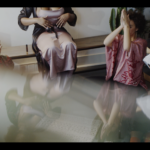
Evan Ifekoya, Undercurrent 528, film still, 2022.
Central to their practice is the concept of ‘Blackness in abundance’, which emphasizes the polyvocality of Black experience, as opposed to any individual voice or position. In ~Resonant Frequencies, Rebekah Alero, Rahima Gambo, Maïa Nunes, Maïté Chénière (a.k.a. Mighty) and MINQ to contribute to the audio piece, which melded excerpts of Ifá, the Yoruba divination system, interspersed between impromptu melodies and spoken word. “I don’t want the work to be pedagogical,” explains Ifekoya. “Part of my inquiry is looking at things from everyday life and asking myself, how do I lay these out in some way, and open them up so that somebody may get something from them, which diffuses into their own awareness of consciousness.”
There’s different ways that you can answer the question. I think that sound can be a portal in a sense that it can be a possibility for you to be open and to stay open. You can experience sound as something that’s fluid and porous. You can take in certain qualities of sound and let yourself be affected by them and internalize them. You can also open yourself to other listening experiences that throw you off a bit.
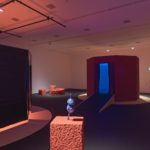
Evan Ifekoya, ~Resonant Frequencies’, installation view at Migros Museum, Zurich, 2022. Photo by Stefan Altenburger.
Just before Ritual Without Belief, presented at London’s Gasworks in 2018, Ifekoya spent some time at the Octavia E. Butler archives at the Huntington Library in Los Angeles. Deep in their own research of Black queer organizing in London and the UK, with a focus on the construction of community spaces in the 80s and 90s and the symbiotic relationship between pleasure and politics, Ifekoya was drawn to the affirmations Butler would write to herself as she crafted her narratives. “These cards were a kind of world-building, a constellation manifesting and naming a world she wanted to live in,” suggests Ifekoya. “This idea of the archive really fed into that show, where I created a kind of social space that also functioned as an active archive.”
Ritual Without Belief operated on its own time, the circular and linear intersecting throughout the duration of the show. At its core was a six-hour-long sound piece that Ifekoya refers to as a “Black queer algorithm”; made in collaboration with friends and family, it contains breathing meditations, readings of literature and theory, and fragments of intimate conversations. Every hour, the disparate pieces of the work reorient around a central refrain: “Can I catch my breath?”
The gallery was overlaid with an ocean-print vinyl floor; in the back room, a wave curls up and over itself, its crest disintegrating into dozens of multicolored balloons that slowly lost their helium throughout the duration of the show. The balloons hover over Bodybuilder with Bra (1990), a black and white photograph by London-based artist Ajamu that had not been shown publicly since the mid-90s, ultimately landing at the image’s feet when the party’s over. Ifekoya reframes the exhibition as an archive within an archive, building a world from their own archive that pays tribute to a historical image of Black queer representation.
I try to create a kind of bodily presence within my work. What is important to me is to create an environment where it feels like that’s possible. What would it feel like to experience your own body in a space? How can I support you to be in relationship to your own body?
I always begin with myself and how I want to be treated in the space. These questions come out of my own personal relationship to my body and the way sound has transformed my body, physically and mentally and spiritually. I think what happens in the queer and trans communities is that we have to negotiate our way through a body that feels like it doesn’t fit, because the body is the first part of ourselves that we encounter in the world. You know, your body is the first part of you that this world interacts with. How can one negotiate that? The first entry point for me is a personal one. I have to begin with my relationship to my body.
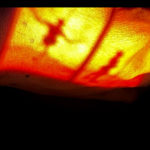
Evan Ifekoya, Undercurrent 528, film still, 2022.
“There’s a José Esteban Muñoz quote that goes, ‘a backward glance that enacts a future vision,’” suggests Ifekoya. “And I think that’s kind of what I’m always doing with my work. I’m taking a look back so that I can imagine a new kind of future, because the present isn’t enough. What else is possible?”
Recently my work has been about dreaming, in the present, about our potential future. My new project comes out of a desire to use sound and the voice as a tool to access different kinds of psychological, emotional and physical spaces. Sound and voice are really connected to the body and the mind. So the work has been really about exploring the potential of what it means to use the voice, and sound, as a way to access these alternative states of consciousness.
Ifekoya’s work has always been concerned with the voice, and these worlds meld particularly in Undercurrent 528, a film produced during the pandemic. Framed by the artist’s research into Solfeggio frequencies – specific tones for balancing energy, for harmonizing the mind, spirit, and body – as well as the affective potential of drumming, the work ripples between documentation and liveness. It unfolds across scenes of a breath-work workshop conducted in the artist’s home, cut with studio scenes of drummer Remi Graves, as they explore the instrument’s capacities for Black resistance, joy, and rhythm.
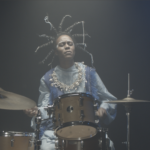
Evan Ifekoya, Undercurrent 528, film still, 2022.
Ifekoya’s voice overlays the visuals – sometimes instructional, sometimes directed towards the listener, the self, or an elemental energy – and is combined with a score produced by Tygapaw. The film filters through various reigns of attentiveness and presence as it stretches around the specific rumble of 528 – a frequency associated with love, clarity, and mental peace – becoming both a tribute to the collaborative world-building that saw Ifekoya and their community through the pandemic, and a meditation on future worlds to come.
You know, it’s so much more about co-creating a collective state of consciousness in a very new way – a way that’s so much more inclusive, and which does not reify the idea of a hierarchical structure in a creative or a spiritual practice.
The whole world is a portal, and we’re the ones who are opening and closing it. When we’re able to hold this kind of frenetic multiplicity at once, it’s challenging, but it’s also quite beautiful.
Across Ifekoya’s practice is a desire to undo the boundaries between maker and receiver, conscious and unconscious, individual and collective, past and future – boundaries that behave as superstructures to pick at and delineate our senses and selves; boundaries that facilitate, as writer Eve Kosofsky Sedgwick suggests, a paranoid reading of the world. Rather than excavating or closing down on the moving target of feeling, Ifekoya’s practice begins from the position of exploration, of opening it up, of sharing that space, that ritual environment. Like Butler’s affirmations, their work attests that there is no ritual without belief, no world-making without community. “All of my work is an attempt to resist this idea of me having authority over the viewer, over the listener, over the person experiencing the work,” explains Ifekoya. “It comes out of a desire to disrupt and not wanting to fix anything too solidly in place – to keep things malleable and moving and liquid.”
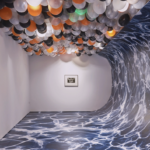
Evan Ifekoya, Ritual Without Belief, installation view at Gasworks, London, 2018. Photo by Andy Keate.
This morning I had a really interesting experience. I was talking to a friend and they were talking about how they’d do emotional work at a certain time in their life. In my own practice, there’s a way of being that I try to be in, which is this deep listening, this place of just being and witnessing.
In the moment I’m in now, I’m in deep listening with you – with you in particular, but also the other folks that I’m in the space with. I always find when I begin to do deep listening with someone, I become more malleable. My whole being begins to open up, my whole sense of self begins to transform. I feel myself becoming malleable in order to receive the other person. I feel myself become malleable so that I can receive the present moment, so I can be a witness to that present moment. So, deep listening is a way of being malleable. That’s what I learned this morning, by being in deep listening with a friend. It was so beautiful – to be malleable, and to become a messenger.











